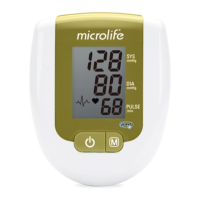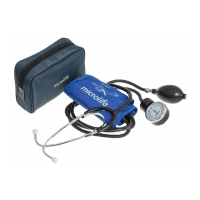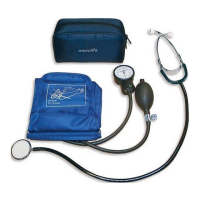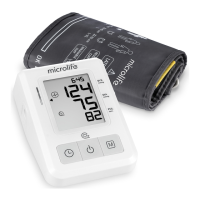3
www.microlife.com BP 3BM1-3 Automatic Blood Pressure Monitor Instruction Manual
2
BP 3BM1-3 Automatic Blood Pressure Monitor Instruction Manual www.microlife.com
1. INTRODUCTION
1.1 Features of your BP 3BM1-3
• Your blood pressure monitor BP 3BM1-3 is a fully automatic, digital blood pressure meas-
uring device with integrated PAD technology for use on the upper arm. This monitor
enables very fast and reliable measurement of the systolic and diastolic blood pressure
as well your pulse by use of oscillometric method.
• This device is easy to use and is proven in clinical studies to provide excellent accuracy.
The large display makes it easy to visualize operational status and cuff pressure during a
measurement.
• Please read through this instruction manual carefully before use and then keep it in a
safe place. For further questions on the subject of blood pressure and its measurement,
please contact your doctor.
1.2 Important information about self-measurement
• Self-measurement means control, not diagnosis or treatment. Your values must always
be discussed with your doctor. You should never alter the dosages of any medication
without direction from your doctor.
• The pulse reading is not suitable for checking heart pacemakers!
• If you have been diagnosed with a severe Arrhythmia or irregular heartbeat, measure-
ments made with this instrument should only be evaluated after consultation with your
doctor.
Electromagnetic interference:
This device contains sensitive electronic components.
Avoid strong electrical or electromagnetic fields in the
direct vicinity of the device (e.g. mobile telephones,
microwave ovens. Electrical interference can lead to tem-
porary impairment of the measuring accuracy).
2
2. IMPORTANT INFORMATION OF BLOOD
PRESSURE AND ITS MEASUREMENT
2.1 How does high/low blood pressure arise?
Your blood pressure level is determined in the circulatory center of your brain. Your nervous
system allows your body to adapt or alter blood pressure in response to different situations.
Your body alters your pulse and the width of blood vessels through changes in muscles in the
walls of blood vessels.
Your blood pressure reading is highest when your heart pumps or ejects blood. This stage is
called your Systolic Blood Pressure.
Your blood pressure is lowest when the heart rests.
(in-between beats) This is called your Diastolic Blood
Pressure.
It is critical to maintain blood pressure values within a
"normal" range(s) in order to prevent particular diseases.
2.2 Which values are normal?
• Blood pressure is too high if, the diastolic pressure is above 90mmHg and/or the systolic
blood pressure is over 140mmHg at rest. If you obtain readings in this range, consult your
doctor immediately. High blood pressure values over time damage blood vessels, vital
organs such as the kidney and even your heart.
• When blood-pressure values are too low, i.e. systolic values under 100mmHg and/or dias-
tolic values under 60mmHg, consult your doctor.
• Even with normal blood-pressure values, a regular self-check with your blood-pressure
monitor is recommended. In this way you can detect possible changes in your values
early and react appropriately.
• If you are undergoing medical treatment to control your blood pressure, please keep a
record of the level of your blood pressure by carrying out regular self-measurements at
specific times of the day. Show these values to your doctor. Never use the results of
your measurements to alter drug doses by yourself without consulting your doc-
tor.
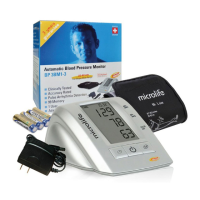
